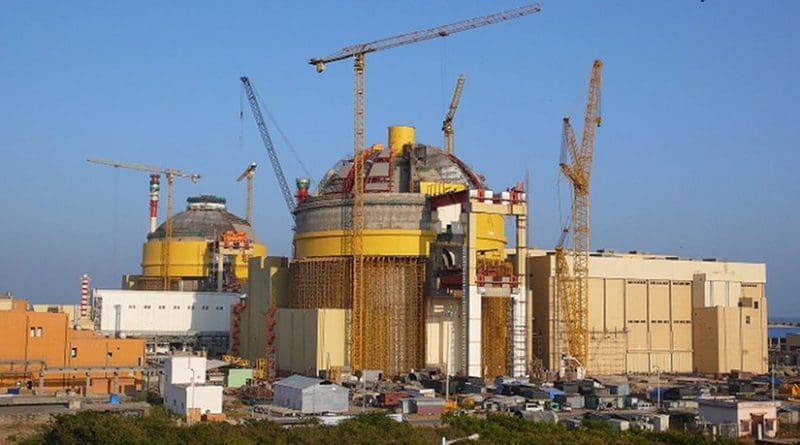Muddled Up Views On India’s Nuclear Program – OpEd
Mr Usman Ali Khan’s muddled up OpEd (Indian Nuclear Muddle, May 15, 2015) on India’s nuclear program is tellingly short on facts and abundantly long on unsupported opinions.
Pakistan plans to increase its nuclear power capacity from 725 MW to 8800 MW by 2020. India hopes to increase it from 5780 MW to 27,800 MW by 2024. Mr Khan ably supports Pakistan’s program (Pakistan and the Nuclear Option – OpEd, March 11, 2015). However, he portrays India’s plan as “nuclear lust”!
His assessment that the Indian Nuclear Power Industry remains “shrouded in secrecy and opacity, refusing to reveal details on safety”, is incorrect.
Indian Parliament reviews the activities of the Nuclear Power Corporation of India (NPCIL). The Comptroller and Auditor General (CAG) of India audits NPCIL’s accounts.
Atomic Energy Regulatory Board (AERB) publishes safety performance of India’s reactors and describes incidents relevant to safety. The reports to the Convention of Nuclear Safety and safety information exchanged between India and the International Atomic Energy Agency are equally useful. If NPCIL is secretive, one would not see such details in public domain.
Khan parroted the views of professional critics for whom anti nuclear sentiments are articles of faith. Fair enough, for their survival, they will have to frame all nuclear incidents big or small in a particular angle. They use catchy anecdotes, rants of individuals with hurt egos and some facts cleverly mixed with fiction in their “analysis”! Relying on such reports, Khan conjures up catastrophic nuclear events in India.
He deftly ignores India’s achievements.
India operates seven uranium mines and two mills; fabricates fuel elements; produces heavy water; designs, constructs and operates nuclear power reactors; reprocesses used fuel and develops advanced waste management technologies.
NPCIL is erecting four nuclear power reactors of 700 MW capacity at Kakrapar and Kota and plans to install more Light Water Reactors and Pressurized Heavy Water Reactors at four additional sites. India may commission its prototype fast breeder reactor (500 MW) shortly.
The Unit 5 of the Rajasthan Atomic Power Station operated continuously for 765 days, second longest in the history of nuclear power and the longest in the last two decades. With average Plant Load factors of 83% in 2013-14, Indian reactors are performing well.
From a fleet of 20 nuclear power reactors, NPCIL earned a profit after tax of Rs. 22,990 million during FY 2013-14.
Units 1 &2 of Tarapur Atomic Power Station provide the cheapest non hydro power to the Indian grid at Re 0.97 (US$ 0.014) per kWh. The average tariff of nuclear power at about Rs2.71 ($ 0.044) per kWh in 2013-14 is comparable to those of other sources. The cost of power from the latest commissioned Kudankulam plant is Rs 3.94 (US$ 0.0645) per kWh.
Can what Mr Khan calls as a “chronically inadequate management”, achieve all these?
India’s latest report to the Convention on Nuclear Safety proves that Khan’s claim that India “simply shrugged off the Fukushima experience” is without any basis.
He portrays the villagers’ protest against Jaitapur nuclear power plant as an indication of repeated failures at different plant sites in India. Acquisition of land for projects including nuclear projects is a contentious issue.
In the 2014 general election, S P Udayakumar, an anti nuclear activist who contested on the issue of Kudankulam Nuclear Power Plant secured 1.53% (15,134 out of 9,90,337) the votes polled!
Activists may stop kite flying! Villagers of Jaitapur will find reason. Once they receive good compensation, they will accept the plant in their neighborhood.
“The story is one of ignorance, lack of adequate regulation, and finally a total breakdown of institutional responsibility within the Indian republic. They are consuming and bathing in nuclear poison”. Khan’s lament belongs to that of an activist.
When lack of domain knowledge and blind environmental activism combine, sobriety suffers.
Regrettably, Mr Khan who competently defends Pakistan’s nuclear power program (Pakistan Nuclear Energy: Let There Be ‘Light’ – OpEd Eurasia Review, April 13, 2014) behaves like an activist while reporting on India’s program!
The Atomic Energy Act 1962, rules issued under it and AERB’s safety codes and standards form the legal frame work governing India’s nuclear program. Various agencies and authorities fulfill their mandates. Khan’s tale on the “breakdown of institutional responsibility” is the product of a fertile imagination.
Khan finds a 16 year old article by Mr Gopi Rethinaraj as supporting his wrong notion that Indian nuclear establishment is virtually unaccountable to anyone. Rethinaraj claimed that the Department of Atomic Energy exploited the ignorance of India’s judiciary and political establishment on nuclear issues, implying thereby that journalists like him were cleverer as they knew nuclear matters!
Do not believe Rethinaraj. Independent study would show that nuclear legislation of virtually every country contains some provisions to maintain secrecy. Khan may inform Rethinaraj that presently furnishing dose records to radiation workers is mandatory in India
In conclusion, “India’s nuclear muddle” is a tale told by someone, “full of sound and fury, signifying nothing”.

